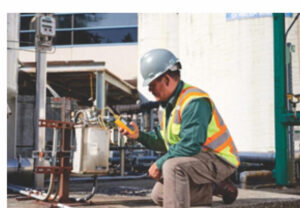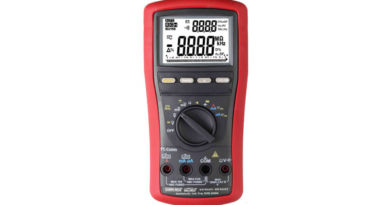Twelve Common Industrial Ethernet Mistakes


Whether you’re a process or plant engineer, atechnician, or an electrician, you’ve got to be an
expert in a wide array of areas today–including Industrial Ethernet (IE). Sooner or later, you’re going to run into a problem caused by others who aren’t as well-versed in the vagaries of this networking technology. Here are the worst
problems that you may face when dealing with Industrial Ethernet. Hopefully, you can find and
correct them (or, better yet, avoid them) before they lead to plant downtime.
1. Using office-grade connectors, cables, and network gear. It’s true that much of the
customer- and office-grade equipment out there will work with Industrial Ethernet. But the
question is, for how long? Non-industrial gear isn’t ready for the vibration, moisture, electrical
interference (EMI), chemicals, and more that you’ll find in a plant. Smart people realize this, but
sometimes they use suboptimal gear for a quick fix to get operations back up and running.
Since quick fixes are often forgotten, it’s best to avoid using non-industrial gear for your
Industrial Ethernet.
2. Careless cable routing. Some cabling is designed to handle the worst of all the MICE
(mechanical, ingress, climatic, and electromagnetic) environments, so you can be a little looser
in how you route that cable. In most instances, however, cabling has some limitations, and you
need to be aware of those limitations when routing it. Is it too close to electromagnetic
interference sources like Variable Frequency Motor Drives (VFD)? Are there areas where it will
get too hot or exposed to harsh chemicals or just plain water? The worst part about making this
mistake is that the cable will function properly—until things change just enough to cause a
failure.
3. Not labeling your cabling installations. Just as plants have requirements and standards for
the labeling of piping and conduit, so does cabling (see TIA 606-B). The issue here isn’t safety,
but time and frustration. Knowing which cable goes where can save vast amounts of time when
troubleshooting or upgrading.
4. Not testing cabling before installing a new line. Verifying your cabling can save hours of
time when you’re installing and starting a new system. While a quick check of the cable takes
only seconds, problems like an improperly terminated connector, or a cable that’s too long or
susceptible to EMI can take hours to troubleshoot and lead to finger-pointing and project delays.
5. Not testing extended cabling parameters. Basic cable testing, as described in number 4
above, can help ensure that the cabling is installed properly, but it can’t tell you how it will
perform. Advanced testers measure many more parameters, such as crosstalk (which affects
the throughput of the cable), resistance and return loss (which can indicate connectors that are
susceptible to vibration or moisture), and transverse conversion loss (which indicates
susceptibility to electromagnetic interference). Ensuring that cabling meets performance
standards for these parameters provides assurance that the cabling will work not only at startup
but well into the future.
6. Using “digital extension cords.” One quick fix that’s often attempted for a cable that isn’t
performing properly is to connect it to an unmanaged switch somewhere in the middle of the link
and run a cable from there to the end device. While this sometimes works, it adds a point of
failure, which is especially problematic if the device is an office- or consumer-grade product.
Worse, when connected like this, the device can’t be controlled and is in fact “invisible” to
network management or any tech trying to troubleshoot a problem.
7. Trusting the “Link Light” LED. Connecting a cable to a device and seeing the Link LED
illuminate is satisfying, but it’s not a guarantee that the communications link is working properly,
or even at all. The link light will typically come on whether the communications are solid or
barely working – which means very little margin for error. Most experienced networking techs
can tell you stories of the time the light came on when the link didn’t work at all or wasn’t even
connected. That’s why they don’t trust those lights, and neither should you.
8. Performing “swap- ‘til-you-drop” troubleshooting. When your Industrial Ethernet network
stops working, it looks good and feels good to start fixing things. Unplug and plug things. Try a
different switch port. Route a new cable. Replace a controller. Unfortunately, this scattershot
approach has multiple problems. First, you could waste a lot of time fixing things that aren’t
broken. Second, it can be costly to replace things that aren’t broken. Third, and worst of all,
since you don’t know what the problem was when your communications start working again, you
can’t be sure you’ve really solved the issue or if it will be back again to ruin your day tomorrow.
9. Being unprepared for the leading cause of Industrial Ethernet failures. Research shows
that the most common cause of Industrial Ethernet failures is cabling and connectors. The good
news is that with a small investment you can be ready to quickly pinpoint and repair them.
Having a cable tester—even a basic one—on-site not only enables you to determine if the
cabling is at fault (if not, you can focus on the real problem) but also tells you where the problem
is—most commonly a connector. Having termination tools and replacement connectors (maybe
even spare cabling) onsite will save hours or days compared to purchasing them or hiring an
expert.
10. Neglecting fiber inspection and cleaning. If your Industrial Ethernet installation includes
fiber, you know that the most common cause of fiber failure is contaminated connector
endfaces—an especially severe problem in dirty or dusty factory environments. Since fiber
connections handle more data and are more likely to be critical, failure can be catastrophic.
Avoid problems by inspecting and, if necessary, cleaning and re-inspecting any fiber
connections whenever they are connected or re-connected.
11. Installing Fiber Optic cable and not testing it. Fiber Optic cable is often used between
the access switches (usually near a machine) and distribution or core switches. They are also
used in place of cable runs too long, or inhospitable to copper cable. But like many network
components, a marginal fiber link may work well at startup, only to give you trouble down the
line. Testing the fiber after it’s installed ensures that it exceeds performance requirements and
can even pinpoint potential points of failure.
12. Excessively long cables. No matter how good your copper or fiber cable is, there are
limits to how long it can be. The danger of exceeding these limits is not only that it won’t work,
but worse, that it will work intermittently– leading to unplanned downtime. Testing your cables
before startup or during troubleshooting can tell you if they’re too long. What most people don’t
know is that cabling performance degrades as the ambient temperature rises. Cabling
standards acknowledge this by applying a “derating” factor to copper cables in high temperature
locations, resulting in a shorter allowable length. You can check for this issue by measuring
Insertion Loss (IL) and Return Loss (RL) of the cable at operating temperature to make sure
these critical measurements are within limits. For situations where you need a link that’s too
long for standards, talk to your cabling vendor about specialized cabling designed to extend
copper operating distance for your MICE environment.
For more Industrial Ethernet resources visit us
at www.flukenetworks.com/industrialethernet/resources.



